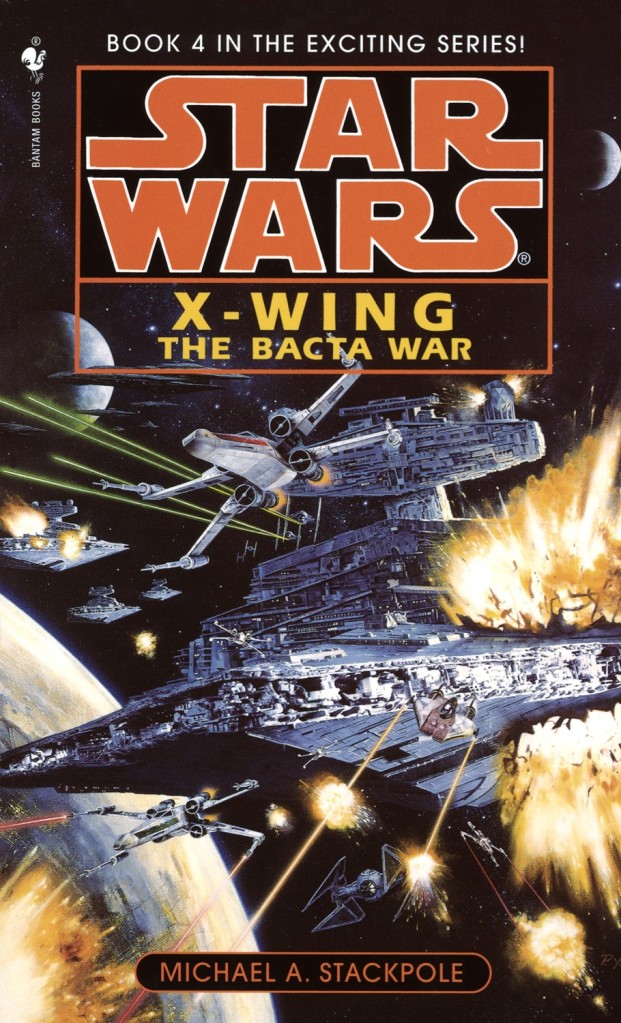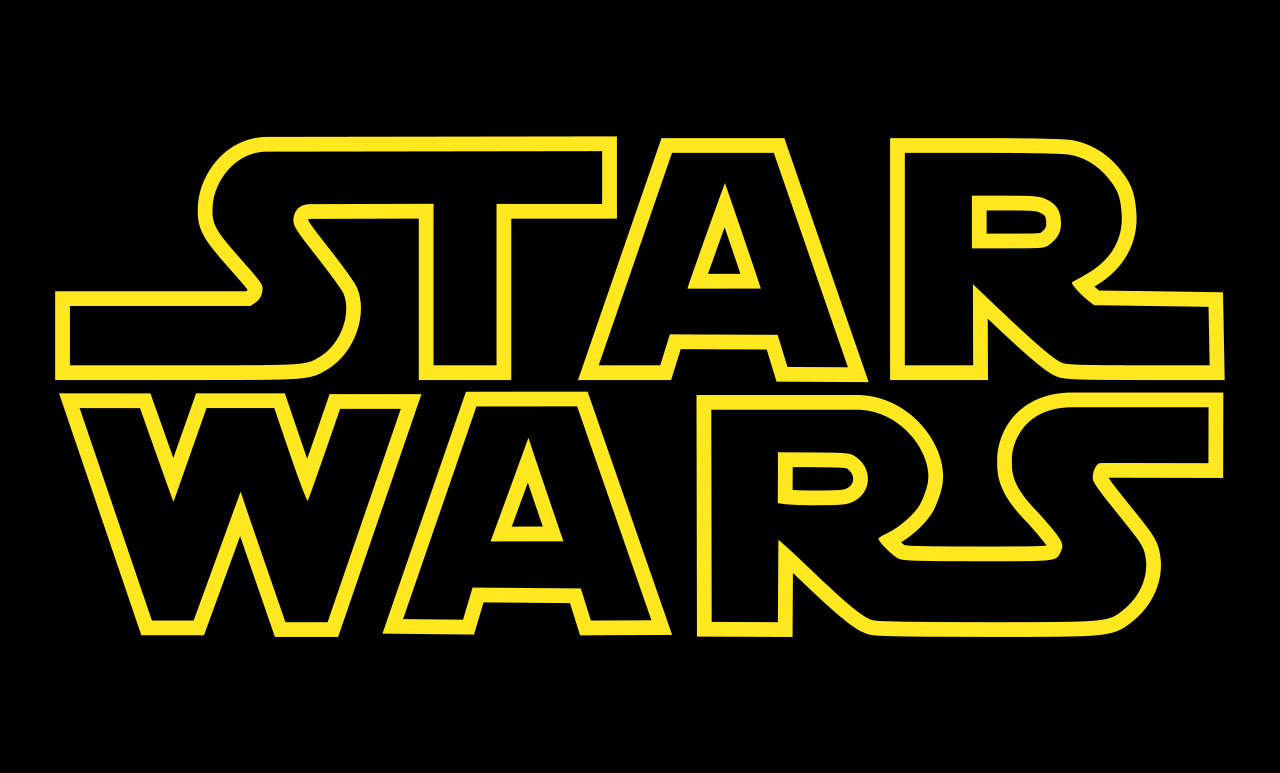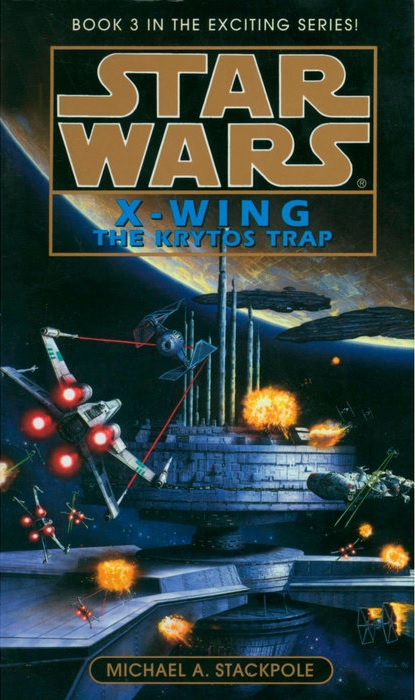I have to admit up front, I’m a little ashamed of myself every time I return to this series. My goal was to, y’know, be quick about it; but it’s taken me a few years to get this far. There are no excuses, but there are reasons; the Star Wars EU is one among several reading lists I’m working through; I don’t read quite as quickly as I once did; and I have a full-time job and a family on top of doing the things that feed this blog. Still, I feel a bit guilty about it.
I feel even more guilty, though, when I realize–very much to my chagrin–that I didn’t post a review for the last book I completed! So, today, we’ll be talking about two novels in the X-Wing series, both by Michael A. Stackpole: Books three and four, The Krytos Trap and The Bacta War.
The standard disclaimer, and a quick recap: When I post about Star Wars, I generally only post about the Expanded Universe, or “Star Wars Legends”, as it was relabeled at the Disney takeover of the franchise. I’ll be honest: I prefer the older work to the Disney canon. I think that it’s a better story, even at its low points, and that Disney would have been well served to port it over to television and film rather than going their own way. Now, that in no way means I dislike everything about the Disney canon; without it, we wouldn’t have Rogue One or The Mandalorian. Nor are my posts here to talk shit about Disney, as it were; I acknowledge it up front, and then basically ignore it. If canon is your preference, I respect that; thanks for coming by, reaching out of your comfort zone, and seeing what the EU is all about! It’s where I have most of my experience, and it’s what I love, so I like to talk about it here.
To recap: We’re covering the EU novels from the post-Return of the Jedi era (plus a few other bits and pieces). Thus far we’ve covered The Truce at Bakura (taking place hours after the end of Return of the Jedi), the trilogy of Dark Forces novellas, Luke Skywalker and the Shadows of Mindor, and the first two entries in the X-Wing series, Rogue Squadron and Wedge’s Gamble. We will–hopefully–be covering all the adult-level and teen-level novels (i.e. Young Jedi Knights), as many short stories as I can acquire, and a few comics (such as Dark Empire), from The Truce at Bakura to the end of the EU. We will not be covering stories explicitly aimed at children, such as Junior Jedi Knights and Galaxy of Fear; most comics; any video games; or any televised media. There’s only so much time, and I’m already taking too long.
Rogue Squadron re-established the titular Rogue Squadron of X-Wing pilots, under the command of veteran pilot Wedge Antilles, who is possibly the most underrated hero the Rebellion ever had, in my opinion. The squadron includes–and the novels generally focus on–future Jedi Corran Horn, who is hands down my favorite EU character. The book establishes the fight to take the capital world of Coruscant and unseat Imperial Intelligence Director Ysanne Isard, pejoratively called “Iceheart” by her friends and enemies alike. In Wedge’s Gamble, after several campaigns across the galaxy, the Rogues take the fight to Isard, and ultimately liberate Coruscant–but all within Isard’s plan, as she releases the engineered Krytos Virus, which targets non-humans. Worse for the Rogues, Corran is captured and held in the infamous and secretive prison, Lusankya.
And that’s it! Spoilers ahead for books three and four (if you’re concerned about spoilers for a book that’s 23 years old, that is). Also, a reminder that because we’re covering two books, this post will be longer than usual.
Rarely have I enjoyed a Star Wars novel as much as The Krytos Trap. It’s not that the book is particularly well written–it’s as good as the rest of the X-Wing series, but not a standout among them. (That doesn’t mean it’s bad, either!) It’s not revolutionary in its characters or even its plot; it concerns the battle to take an impossible target, and that’s the most Star Wars plot ever. Rather, it shows us what the fast-moving, focused movies can’t: Real life in the Star Wars galaxy. We get views of Coruscant’s common people and life beneath the skyscrapers and towers, and we see some of how life must have looked both under the Empire and during transitions. It’s a great glimpse into things that are normally passed over by the heroes and villains alike; in that regard it’s a bit in line with what we’ve seen more recently in The Mandalorian. To be fair, this began in the previous book, Wedge’s Gamble; but it continues here.
The story has two plotlines at play, with occasional commentary from Isard’s faction on both lines. On one hand we have the Rebels–excuse me, the New Republic, for they’re the legitimate government now that they’ve taken Coruscant–discovering and fighting the Krytos virus. Again, this started in the previous novel, but it comes to a head here. Only bacta–the healing liquid that seems to be a cure-all–can properly treat the virus; but bacta is already in short supply, and soon to get worse. This creates a secondary problem: How can the Republic distribute the dwindling supplies without seeming to favor one group over another? It’s Isard’s plan to allow the Republic to destroy itself from within in this way. The Republic does develop a substitute substance, ryl’ca, developed largely from the Twi’lek drug ryll, but it’s essentially a stopgap measure to relieve the pressure until more bacta can be acquired.
On the other hand, we have Corran’s imprisonment. His friends believe him to be dead, and have compelling reason to blame Tycho Celchu–once a Lusankya prisoner himself–for the catastrophe. Wedge maintains Tycho’s innocence, but it’s a battle he can’t win. Meanwhile Isard tries desperately to turn Corran into a sleeper agent, but fails. She dumps him in with the general prisoner population; but this, too, turns to his advantage, as he meets a remarkable older man named Jan. Unbeknownst to Corran, this is Rebel general Jan Dodonna, presumed dead since the Battle of Yavin; but he conceals his identity, because he knows he is the only thing keeping the other prisoners going. Nevertheless, he and his men assist Corran with an escape attempt.
The story comes together as Corran makes his escape. Along the way, he learns two stunning truths. First, his father was not who he claimed to be; though he grew up as Hal Horn, he was actually Valin Halcyon–the son of slain Jedi Master Nejaa Halcyon. Coran learns that he himself is heir to that Jedi tradition and power, and he finds and claims Nejaa’s lightsaber as his own. Second, he learns that Lusankya is not a building after all, but a Super Star Destroyer like Vader’s ill-fated Executor–and it is buried under the surface level of Coruscant. Before he can use that knowledge, however, the ship tears itself free of the city, causing massive casualties; and Isard makes her escape.
Corran is, however, able to provide evidence that exonerates Tycho…just as his old enemy, Kirtan Loor, is killed by the real sleeper agent, former prisoner (and Iella Wessiri’s husband), Diric Wessiri. After the trial, Corran is approached by Luke Skywalker, who asks Corran to study under him and become a Jedi Knight; but Corran declines, stating his first loyalty is to the Rogues. On the heels of this choice, however, comes news that Isard has established herself in a coup on the planet Thyferra, the source of nearly all the bacta in the galaxy–and because of the Republic’s political arrangements, no mission can be staged to liberate the planet. Thus, as one, the Rogues resign their commissions, and set out to wage a private war to bring Isard down.

The Bacta War sees the prosecution of that war. While Isard entrenches her position with three more Star Destroyers in addition to the Lusankya, the Rogues prepare to take the fight to her–but first, they have to acquire the means to do it! Their ships and gear are all Republic property, and so Wedge and Tycho set out to acquire new equipment. Fortunately, Isard’s frame-up job against Tycho included a very large sum of money to indicate his alleged corruption; and that money is available to him now. A little maneuvering by a supporter within the Republic results in much of their original equipment coming up for sale; and some help from Republic pilot Pash Cracken sees a space station in the Yag’dhul system erroneously listed as destroyed, giving them a base of operations. The Rogues soon acquire new allies in the form of Mirax Terrik’s retired-smuggler father, Booster Terrik, and current smuggler-entrepreneur Talon Karrde.
Meanwhile, Isard grows increasingly unhinged as she focuses in on taking down Wedge and his people, leading her advisor Fliry Vorru to conspire with former Rogue and traitor Erisi Dlarit against her. Through a number of stratagems, Wedge and his allies slowly whittle down Isard’s forces, first destroying the Victory II-class Star Destroyer Corrupter, then buying out the services of the captain of the Imperial II-class Virulence. At last he leads the Lusankya into a complex trap at Yag’dhul, allowing him to make a final assault on Thyferra and Isard. The Lusankya is freed by the actions of its escort, the Imperial II-class Avarice; but when it jumps back to Thyferra, it is overwhelmed in record time by a multilayered attack from the Rogues, their allied fighter pilots, several other ships adapted for the purpose, and the Virulence. Ultimately the Lusankya‘s XO assassinates its now-insane captain, and surrenders the ship. Vorru is captured, tried, and returned to imprisonment on Kessel; Irisi is killed by Corran in a dogfight over Yag’dhul’s moon; and Isard is (apparently) killed in the destruction of her escape shuttle (though I’m not convinced). In the end, Booster acquires the Avarice, renaming it the Errant Venture; Karrde facilitates some very profitable deals; the Rogues are reinstated into the Republic; and oh yes, Corran and Mirax get married (much to Booster’s consternation).
Whew! That’s a lot of ground–err, space–to cover.
Thus far I’ve been generally pleased with the X-Wing series. It wasn’t until preparing to write this post that I realized that the series has multiple arcs (I know, I know, I should know better…); and now we’ve reached the end of the first one. Next time, we’ll be picking up the tale with a new squadron, new characters, and a new mission. It’s a little bittersweet to realize; I’ve been having fun with Corran, Gavin Darklighter, Mirax Terrik, Tycho Celchu and the rest. They’ll be back, but we have a lot of material to read before then!
Corran Horn remains my favorite EU character. I was introduced to him, many years ago, in *I, Jedi* (also written by Stackpole), and have been a fan ever since. He’s very much in the rough here; he has a long way to go. But in this novel we get the payoff of what’s come before; he knows about his Jedi heritage and is starting to feel it out; he’s no longer imprisoned by Isard; he’s overcome his rivalry with Bror Jace (who–spoiler!–isn’t as dead as we thought); he’s past the awkward bit of his budding relationship with Mirax (and now has an awkward, budding relationship with her father). He’s starting to smooth off the rough edges and become more mature, and I’m happy to see it. He’s actually sidelined a bit more here; Mirax Terrik and Iella Wessiri move to the forefront, and Wedge gets more screentime, as do Booster Terrik and Talon Karrde, and–most surprisingly, but pleasingly–Ooryl Qrygg, Corran’s Gand wingman.
Ooryl gets the highest honor he can get in Gand society, for his spectacular accomplishments: he becomes janwuine, and gains the right to refer to himself in the first person. It’s a subtle, background plot, but very pleasing when it pays off.
When I first encountered Booster Terrik–I don’t recall which novel–he was already tooling around the galaxy in his personal Star Destroyer, the Errant Venture. As soon as he appeared in The Bacta War, I realized this must be where he acquires it, and I wasn’t disappointed. The scene in which Talon Karrde negotiates between Booster and the Republic for ownership of the Star Destroyer–and gets the better of both of them–is a thing of beauty. ” As Palpatine once said, “we will watch your career with great interest!”
I appreciate the wrap-up to Ysanne Isard’s story. (I know it’s not the final end; after all these years, it would be hard not to know she’s going to put in at least one more appearance. But still, the bulk of her story is tied off now.) I found her to be a compelling villain at first, a sort of dry run for Thrawn’s later appearance. But, in this final novel, she begins to slip into madness, and loses much of her edge–as well as much of what made her distinctive. Her ruthlessness and extreme pragmatism were her “plus one” (see my review of Wedge’s Gamble for what I mean by that), and without it she’s not nearly as interesting. It was very much a relief when her apparent death occurred. The stage quickly gets stolen by former Moff Flirry Vorru and Rogue traitor Erisi Dlarit; but with the pace of the story, neither of them can gather enough screen time to make the impact they should make. There is, instead, a handful of other minor villains, but for the most part they are standard villain fare, and gone as quickly as we meet them. (I do hope, though, to see Captain Sair Yonka, of the Star Destroyer Virulence, again. Again, spoiler ahead! –His defection to the New Republic instantly makes him fascinating, and he gets a great line: “The Empire is dead—we all know that—so this is our buy-in to whatever follows it.” I vaguely recall that he appears again later, but I’m avoiding researching it.)
I’ve really only had two complaints so far about this series. For one, everyone speaks in a highly stilted manner. At first I thought it was just Corran; but by this novel, everyone does it, especially when explaining things. I can sympathize–if you read these posts at all, you know I’m the same–but an author’s job is to ensure that not every voice is his own. The second complaint is that there are a few too many lucky coincidences in these books–too many instances of “right place, right time”, on which major plot points then hang. For example, the Rogues are about to get thoroughly swatted at one point; but they are saved by the appearance of a droid-crewed Alderaanian War Cruiser dating to well before the destruction of Alderaan. That’s a coincidence itself, but it’s compounded by why the ship appeared: Tycho, in a fit of nostalgia, set his ship’s IFF transponder to a code identified with a nearly legendary Alderaanian warship, of which this cruiser was a wingmate, and thus the ship responded to him as though he was the mythical ship. This kind of thing happens often enough that it stretches credibility even to consider the Force to be the answer.
Overall, though, I’ve been pleased with the books, and I highly recommend them. We have three more to go, and then we’ll move on to other novels. See you there!
X-Wing: The Krytos Trap and X-Wing: The Bacta War are available from Amazon and other booksellers.
You can find Wookieepedia’s treatment of the novel here.



